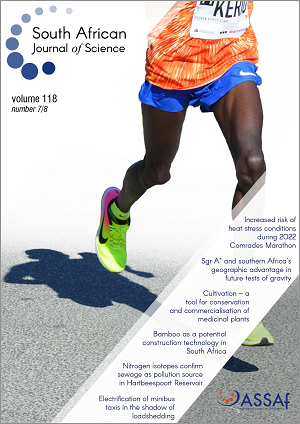Nitrogen isotopes of Eichhornia crassipes (water hyacinth) confirm sewage as leading source of pollution in Hartbeespoort Reservoir, South Africa
DOI:
https://doi.org/10.17159/sajs.2022/11098Keywords:
nitrogen isotopes, water hyacinth, stable isotopes, sewage, HartbeespoortAbstract
Nitrogen (N) isotopes of aquatic organisms offer a way of differentiating sources of dissolved nitrate species in water. Water quality in the Hartbeespoort Reservoir has been a problem for many decades, causing excessive growth of algae and water hyacinth, both of which further cause human health issues, degradation of environmental water quality, and recreational hazards. Six boreholes and four surface water locations were sampled and analysed for certain water quality parameters and stable water isotopes (H and O). Electrical conductivity and pH were acceptable, but faecal coliforms and Escherichia coli were high in the Crocodile River. δD and δ18O showed that there is little groundwater input to the reservoir and the surface water experiences significant evaporation. Six samples of water hyacinth were analysed for C and N stable isotopes. The δ15N values ranged from 20‰ to 33‰, indicating sewage or manure as the primary source of dissolved N in Hartbeespoort Reservoir. As high dissolved N concentrations cause water hyacinth growth to outstrip any manual, chemical or biological control measures, it is suggested that efforts to control the water hyacinth infestation on Hartbeespoort Reservoir focus on informal settlement sanitation and upgrades to sewage treatment works in the Crocodile River catchment.
Significance:
This work is possibly the first report on nitrogen isotopes in plant material to trace water pollution in South Africa. It presents a new line of evidence regarding eutrophication in the Hartbeespoort Reservoir. It indicates the optimal management method for controlling water hyacinth on this and other waterbodies. The study has relevance for agriculture, urban wastewater management, informal settlement sanitation, invasive alien plant control, recreation and tourism.
Published
Issue
Section
License

All articles are published under a Creative Commons Attribution 4.0 International Licence
Copyright is retained by the authors. Readers are welcome to reproduce, share and adapt the content without permission provided the source is attributed.
Disclaimer: The publisher and editors accept no responsibility for statements made by the authors
How to Cite
- Abstract 700
- PDF 624
- EPUB 346
- XML 167













.png)